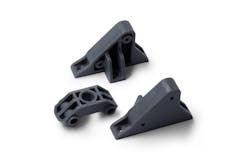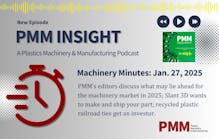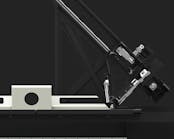Plastics Machinery & Manufacturing is examining aspects of additive manufacturing for production in our latest Cover Story. Come back to plasticsmachinerymanufacturing.com and check out our May print issue for more.
By Bruce Geiselman
3D printing of end-use parts has boomed over the past two years because of COVID-19 and shifting consumer demand, according to a recent global market research report from Formlabs, a leading maker of 3D printers.
Since March 2020, 3D printing adoption rates have soared as consumer behavior and demands changed. Four in 10 respondents surveyed by Formlabs have added 3D printing to their workflows, not just for prototyping, but also for end-use parts. Three in five recent adopters frequently or always use 3D printing for end-use applications to solve supply chain challenges and meet consumer expectations, according to the The 2022 3D Printing Applications Report.
The report is based on market research conducted by Formlabs in collaboration with IndustryWeek and MachineDesign, two Endeavor Business Media-owned publications. Plastics Machinery & Manufacturing also is owned by Endeavor. The findings are based on more than 400 unique responses, according to Formlabs. The respondents were from a wide range of industries, including automotive, aerospace, consumer goods, consumer electronics, entertainment, education, electrical equipment, government, defense, green technology/alternative energy, heavy industry, jewelry, medical, dental, product design and engineering consulting, among others.
Seventy-two percent of respondents currently use 3D printing, while 28 percent do not.
The following technologies were used by the respondents: fused deposition modeling, stereolithography, selective laser sintering, direct metal laser sintering and selective laser melting. Most businesses are deploying multiple technologies. Formlabs did not zero in on metal printing to see if trends for that technology diverged from the overall market.
The report seems to reflect an evolution in attitudes among manufacturers. Beyond R&D and prototyping, companies are now utilizing 3D printing for end-use products to ease supply chain constraints, create limited-run products and personalize devices.
“The COVID-19 pandemic was a catalyst for digital transformation across the economy, especially within manufacturing,” Maxim Lobovsky, co-founder and CEO of Formlabs, said in the press release. “Business leaders are recognizing this and scaling up their 3D printing capabilities. Nearly half of the companies surveyed now have dedicated teams focused solely on additive manufacturing, confirming that we have entered the era of mass production and customization with 3D printing.”
The 2022 3D Printing Applications Report found that recent adopters of 3D printing, defined as those investing in the technology within the past two years, are significantly more likely to print end-use parts.
While rapid prototyping and model making continue to be popular uses for the technology, many businesses have started to deploy it for small-batch custom production and end-use parts. The trend is heavily skewed towards recent adopters, with 63 percent of recent adopters frequently or always using 3D printing for end-use parts, compared to only 33 percent of early adopters.
“Recent adopters of 3D printing have been able to manufacture custom, end-use products at a more efficient rate independent of the state of the supply chain and any disruptions,” Jason Fullmer, COO of Formlabs, told Plastics Machinery & Manufacturing. “Formlabs users across industries such as health care, retail and dental benefit from Formlabs’ diverse ecosystem of printers and our materials library that enables them to manufacture end-use products in-house at an affordable cost, enabling business growth and improved customer experiences.”
Declining equipment costs have contributed to the increased prevalence of in-house 3D printing, the report said. It found that 72 percent of study participants reported their companies currently use 3D printers, with the majority (55 percent of all respondents) printing in-house, compared to 17 percent outsourcing 3D printing.
In-house printing involves an upfront cost, but it lowers the cost per print significantly compared to outsourcing, the report said. It also eliminates shipping costs and delays.
The pandemic also helped spur interest.
“In 2021, 65 percent of recent adopters ranked remote start and monitoring features as important or very important, versus only 32 percent of early adopters,” the report states. “The newer cohort of 3D printing adopters seem[s] to have looked to 3D printing to help them during the pandemic, with 57 percent of them ‘agreeing’ or ‘strongly agreeing’ that their internal 3D printing capabilities are helping to solve supply chain issues.”
A significant number of companies responding to Formlabs’ questions indicated plans for a “large investment” in 3D printing technology in coming years.
“It follows then that the pace of investment in 3D printing seems to be growing, with 26 percent of respondents predicting a large investment in 3D technologies two years from now, and 33 percent predicting large investment in 3D printing five years from now,” the report said.
Contact:
Formlabs Inc., Somerville, Mass., 617-702-8476, www.formlabs.com
Bruce Geiselman | Senior Staff Reporter
Senior Staff Reporter Bruce Geiselman covers extrusion, blow molding, additive manufacturing, automation and end markets including automotive and packaging. He also writes features, including In Other Words and Problem Solved, for Plastics Machinery & Manufacturing, Plastics Recycling and The Journal of Blow Molding. He has extensive experience in daily and magazine journalism.






